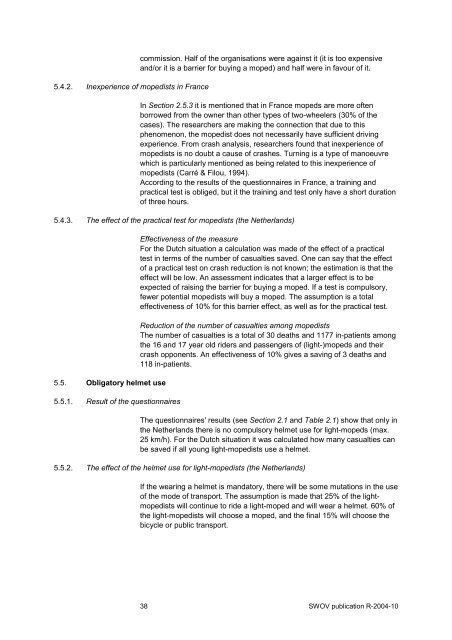Traffic legislation and safety in Europe concerning the moped - Swov
Traffic legislation and safety in Europe concerning the moped - Swov
Traffic legislation and safety in Europe concerning the moped - Swov
Create successful ePaper yourself
Turn your PDF publications into a flip-book with our unique Google optimized e-Paper software.
5.4.2. Inexperience of <strong>moped</strong>ists <strong>in</strong> France<br />
commission. Half of <strong>the</strong> organisations were aga<strong>in</strong>st it (it is too expensive<br />
<strong>and</strong>/or it is a barrier for buy<strong>in</strong>g a <strong>moped</strong>) <strong>and</strong> half were <strong>in</strong> favour of it.<br />
In Section 2.5.3 it is mentioned that <strong>in</strong> France <strong>moped</strong>s are more often<br />
borrowed from <strong>the</strong> owner than o<strong>the</strong>r types of two-wheelers (30% of <strong>the</strong><br />
cases). The researchers are mak<strong>in</strong>g <strong>the</strong> connection that due to this<br />
phenomenon, <strong>the</strong> <strong>moped</strong>ist does not necessarily have sufficient driv<strong>in</strong>g<br />
experience. From crash analysis, researchers found that <strong>in</strong>experience of<br />
<strong>moped</strong>ists is no doubt a cause of crashes. Turn<strong>in</strong>g is a type of manoeuvre<br />
which is particularly mentioned as be<strong>in</strong>g related to this <strong>in</strong>experience of<br />
<strong>moped</strong>ists (Carré & Filou, 1994).<br />
Accord<strong>in</strong>g to <strong>the</strong> results of <strong>the</strong> questionnaires <strong>in</strong> France, a tra<strong>in</strong><strong>in</strong>g <strong>and</strong><br />
practical test is obliged, but it <strong>the</strong> tra<strong>in</strong><strong>in</strong>g <strong>and</strong> test only have a short duration<br />
of three hours.<br />
5.4.3. The effect of <strong>the</strong> practical test for <strong>moped</strong>ists (<strong>the</strong> Ne<strong>the</strong>rl<strong>and</strong>s)<br />
5.5. Obligatory helmet use<br />
5.5.1. Result of <strong>the</strong> questionnaires<br />
Effectiveness of <strong>the</strong> measure<br />
For <strong>the</strong> Dutch situation a calculation was made of <strong>the</strong> effect of a practical<br />
test <strong>in</strong> terms of <strong>the</strong> number of casualties saved. One can say that <strong>the</strong> effect<br />
of a practical test on crash reduction is not known; <strong>the</strong> estimation is that <strong>the</strong><br />
effect will be low. An assessment <strong>in</strong>dicates that a larger effect is to be<br />
expected of rais<strong>in</strong>g <strong>the</strong> barrier for buy<strong>in</strong>g a <strong>moped</strong>. If a test is compulsory,<br />
fewer potential <strong>moped</strong>ists will buy a <strong>moped</strong>. The assumption is a total<br />
effectiveness of 10% for this barrier effect, as well as for <strong>the</strong> practical test.<br />
Reduction of <strong>the</strong> number of casualties among <strong>moped</strong>ists<br />
The number of casualties is a total of 30 deaths <strong>and</strong> 1177 <strong>in</strong>-patients among<br />
<strong>the</strong> 16 <strong>and</strong> 17 year old riders <strong>and</strong> passengers of (light-)<strong>moped</strong>s <strong>and</strong> <strong>the</strong>ir<br />
crash opponents. An effectiveness of 10% gives a sav<strong>in</strong>g of 3 deaths <strong>and</strong><br />
118 <strong>in</strong>-patients.<br />
The questionnaires' results (see Section 2.1 <strong>and</strong> Table 2.1) show that only <strong>in</strong><br />
<strong>the</strong> Ne<strong>the</strong>rl<strong>and</strong>s <strong>the</strong>re is no compulsory helmet use for light-<strong>moped</strong>s (max.<br />
25 km/h). For <strong>the</strong> Dutch situation it was calculated how many casualties can<br />
be saved if all young light-<strong>moped</strong>ists use a helmet.<br />
5.5.2. The effect of <strong>the</strong> helmet use for light-<strong>moped</strong>ists (<strong>the</strong> Ne<strong>the</strong>rl<strong>and</strong>s)<br />
If <strong>the</strong> wear<strong>in</strong>g a helmet is m<strong>and</strong>atory, <strong>the</strong>re will be some mutations <strong>in</strong> <strong>the</strong> use<br />
of <strong>the</strong> mode of transport. The assumption is made that 25% of <strong>the</strong> light<strong>moped</strong>ists<br />
will cont<strong>in</strong>ue to ride a light-<strong>moped</strong> <strong>and</strong> will wear a helmet. 60% of<br />
<strong>the</strong> light-<strong>moped</strong>ists will choose a <strong>moped</strong>, <strong>and</strong> <strong>the</strong> f<strong>in</strong>al 15% will choose <strong>the</strong><br />
bicycle or public transport.<br />
38 SWOV publication R-2004-10

















